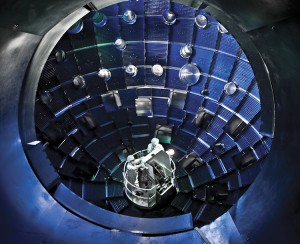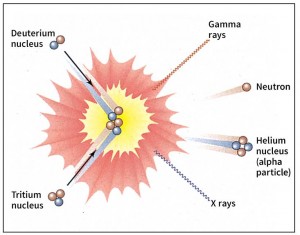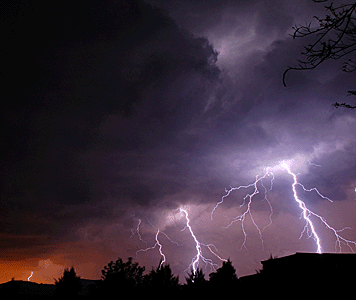One Step Closer to Fusion Power
Monday, January 16th, 2023
A chamber lift in the National Ignition Facility.
Credit: Damien Jemison, Lawrence Livermore National Laboratory
Limitless, pollution-free energy is one step closer to becoming a reality. On Dec. 5, 2022, the National Ignition Facility (NIF) at Lawrence Livermore National Laboratory in Livermore, California, conducted a controlled nuclear fusion reaction that produced more energy than it consumed.
Nuclear fusion is the combining of two atomic nuclei to form the nucleus of a heavier element. Fusion reactions between low-mass (light) nuclei release a great amount of energy. Fusion produces the energy of the sun and other stars and the explosive force of thermonuclear weapons.

Nuclear fusion releases large amounts of radiation. Fusion occurs when the nuclei of two lightweight elements join to form the nucleus of a heavier one. In the example shown here, nuclei of deuterium and tritium unite and form a helium nucleus.
Credit: World Book illustration by Mark Swindle
The NIF uses a technique called inertial confinement fusion (ICF). In ICF, several extremely powerful lasers hit a fuel pellet about the size of a pencil eraser. The lasers heat the pellet to millions of degrees, causing the nuclei within it to undergo fusion and release energy. In this experiment, the lasers heated the pellet with 2.05 megajoules of energy and the pellet released 3.5 megajoules. NIF scientists and engineers improved the design of the fuel pellet and increased the power of the lasers to make this breakthrough.
If the NIF experiment produced energy, why can’t the facility simply be rebuilt all over the world to provide unlimited power? Although the reaction produced more energy than the energy in the laser light, the lasers themselves are too inefficient for a power plant. The lasers used hundreds of megajoules to produce those 2.05 megajoules of energy in the form of laser light. Furthermore, NIF can only perform up to 3 shots per day in its current configuration. Scientists and engineers estimate that a similar ICF facility will need to perform 10 shots per second to become profitable.
Where, then, does this leave fusion development? NIF scientists and engineers will work to improve their energy gains through fine-tuning their fuel pellets and laser output. But the facility was never meant to be a power plant. NIF was designed for research, particularly into the effects of nuclear weapons. The Comprehensive Nuclear-Test-Ban Treaty prohibits the testing of nuclear weapons, but with NIF, scientists can mimic the conditions of a nuclear blast to develop more efficient nuclear weapons.
Many environmentalists have an uneasy relationship with fusion, in part due to its connection with nuclear weapons research. Some also think that functional fusion power plants will come too late to help slow the progression of global warming. Even with this breakthrough, experts predict that commercial fusion plants are likely at least 40 years away. People also worry that fusion research is taking resources away from research into grid energy storage and is detracting from such financially viable alternatives as wind and solar power.
But the prospective benefits of fusion are too great to ignore. Limitless, pollution-free energy is closer than it ever has been—even though it’s still pretty far away. What will people do with all that power?



